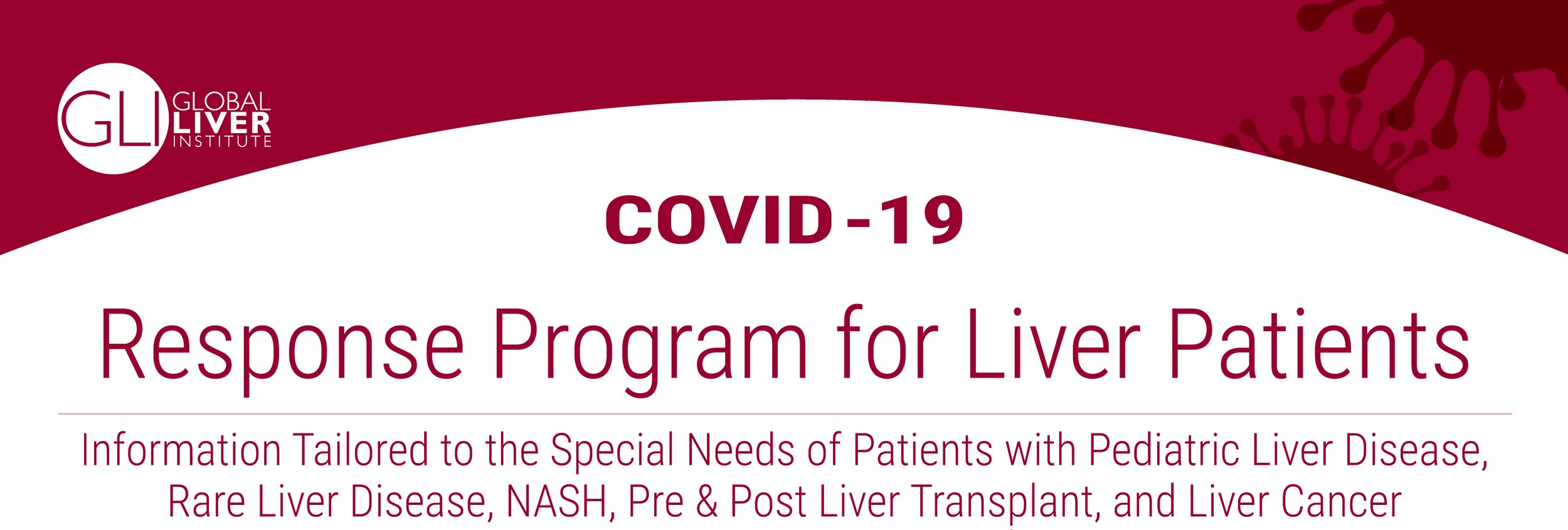 Throughout these past many months, we have all been working to stay safe, healthy, and up to date on all things COVID-19 related. The GLI team has been actively engaging with fellow advocacy groups, healthcare professionals, and liver patients to learn and understand COVID-19 and how it impacts our health and our daily lives. We have been staying connected and educated through our weekly GLI Live events, our medical updates, and our dedicated account for individual responses covid19@globalliver.org. Please subscribe to access all elements of our personalized response program.
Throughout these past many months, we have all been working to stay safe, healthy, and up to date on all things COVID-19 related. The GLI team has been actively engaging with fellow advocacy groups, healthcare professionals, and liver patients to learn and understand COVID-19 and how it impacts our health and our daily lives. We have been staying connected and educated through our weekly GLI Live events, our medical updates, and our dedicated account for individual responses covid19@globalliver.org. Please subscribe to access all elements of our personalized response program.1. As a liver patient, am I at a higher risk of infection?
The data is not currently clear if liver patients are at a higher risk of infection.
CDC has specifically highlighted how liver diseases and cancer are impacted by COVID-19. The increased likelihood of obesity and diabetes associated with NASH patients does put those patients at a higher risk. Those particular pre-existing conditions are commonly cited as putting individuals at an increased risk of COVID-19. For those who were hospitalized, a large majority had pre-existing conditions like those commonly present in NASH patients. Liver cancer patients may also be at a higher risk for severe COVID-19. There is an increased risk for hospitalization and ICU admission for patients with cancer when compared to the general public. It is also possible that liver transplant patients are at a higher risk, in comparison to other types of transplant patients.
Overall, there still remains very limited data on how certain pre-existing conditions, like liver disease, impact the risk of COVID-19 so proper precautions should continue to be taken.
2. As a liver patient, if I am infected will I have a more severe course of the disease?
While there is still very limited data, some immunosuppression drugs may have a positive impact on the outcomes of more severe COVID-19 cases. There have been small studies conducted that have concluded that while they may not reduce the chances of infection, immunosuppressive drugs could potentially reduce the severity and chances of death. Additionally, some early reports from Italy indicate that weaker immune response may lead to a milder reaction and less lung damage.
3. Where can I get tested? Should I get tested? Which tests are valid?
If you intend on going back to work or are increasing your level of activity outside your home you should consider getting tested. You may be asked to be tested before accessing a healthcare facility as a visitor or patient as non-emergency procedures restart.
The ability to get tested varies depending on the state or country you’re living in. Some states have opened up testing for anyone who would like to receive one, while others are still limited for those who have symptoms or require an appointment with a healthcare provider. Each state has resources through its Department of Health which provides specific information regarding who is able to get tested, how you can get tested, and the locations of testing sites. The European CDC provides similar information for European Union countries. As testing has become more widely available, we recommend getting tested as your area begins to reopen.
There are two different types of COVID-19 tests that you can currently take. They are the viral test and the antibody test. The viral test is diagnostic and reports if you currently have COVID-19. The test uses respiratory system samples to identify if the virus is present in your body. The second test, the antibody test, checks for the presence of COVID-19 antibodies via blood sample, which indicates a past infection. You can receive one through a healthcare provider or through LabCorp. For more information about antibodies and the tests, Dr. Saima Ajaz discussed this important topic on a recent GLI Live episode.
4. I am immunocompromised, should I go back to work? What are my rights?
Many people who have an immunocompromised status have been working throughout the pandemic, including nurses, physicians, grocery and other essential workers on the front lines, protecting themselves as best they can through strict personal hygiene and use of personal protective equipment. Schoolteachers and others who have been able to work from home are now in negotiations with state and local governments given that, as a population, their vulnerability differs significantly from the children they teach.
Telework remains the best option for vulnerable people until we get a treatment and/or vaccine, but your ability to do so depends on a patchwork of state and federal legal rights.
Depending on the industry and position, many employers are choosing to permit teleworking into 2021. The Equal Employment Opportunity Commission (EEOC) has created a COVID-19 Pandemic Preparedness in the Workplace document interpreting the Americans with Disabilities Act (ADA) which indicates that telework is an effective method to control the spread of the virus and to protect employees. Requesting telework is considered to be a reasonable accommodation by the ADA for those who qualify.
5. What would a safer workplace look like?
A safer workplace would be one that follows OSHA’s guidelines, CDC guidelines, and your local reopening plan on reducing worker risk of exposure to COVID-19. A safe workplace for liver patients also recognizes risk factors of certain individuals and accommodates their needs.
Ensuring that workplaces have an infectious disease preparedness and response plan, which includes research surrounding federal and state recommendations and resources, and an action plan if an outbreak were to occur in the workplace are two important elements. Ensuring that basic infection prevention measures are put into place within the building, providing personal protective equipment (PPE) when needed, and encouraging and providing resources for proper hygiene is also very important. Implementing appropriate methods of identifying and isolating those who may be sick and providing reasonable accommodations for those who are immunocompromised are also recommended. CDC has recently published a set of recommendations and guidelines for employers to follow to re-open office buildings. Ensuring that the procedures of the company and office space are compliant with CDC recommendations will be very important prior to returning to work.
6. What is the safest way to get to work?
Using personal vehicles is the safest way to get to work, but using ride-sharing services and public transportation can be possible if certain prosecutions are taken.
The safest way to get to work is by driving in a personal vehicle. This helps to avoid unnecessary exposure to others and public surfaces that are frequently touched. Frequent cleaning of commonly touched areas like door handles and steering wheels is important in keeping personal vehicles clean and safe.
Using a ride-sharing service is also an alternative to avoiding public transportation. Uber and Lyft have implemented guidelines for drivers and passengers to help ensure the safety of both parties. Sitting in the back seat, requesting the windows remain down, and frequently using hand sanitizer are all ways to help mitigate risk.
If using public transportation is unavoidable, there are a few ways to help stay safe. They include avoiding touching surfaces like handrails, using touchless payment methods and doors when possible, trying to maintain distance between yourself and other passengers, traveling during non-peak hours to avoid crowded buses and trains, using hand sanitizer after touching surfaces, and wearing a mask. It is also important to consult local public transportation agencies to learn about their specific COVID-19 guidelines and any potential service disruptions.
From the Transplant Patient-In-Chief
Due to GLI’s COVID-19 Response Program, which launched in March on top of every other GLI program for liver health, work has been more intense than ever. It is a blessing to have a job, and to have a purpose during this time and to be able to work remotely throughout. Zoom (and to a lesser degree Microsoft Team, Skype for Business, and Facetime ) has been my new business world. The biggest change and silver lining for me is how many more patients I am in contact with throughout the day, throughout the week via text, email, LinkedIN, video, and online groups. I have learned so much and hope I have contributed a bit more of me the person and patient vs. me the CEO than usual. Team GLI has been working on an office re-open plan using the principles and decision trees referenced in this update. We will be guided by the infection rate, hospitalization rate, and ICU utilization in the area around our offices; the availability of testing for staff, and the ability to safely design the office and the route to the office as well as risk factors affecting individual team members. Introverts and extroverts alike are missing each other, the team dynamics, and project processes that would be easier in person, but we value each other and our lives, and our ability to serve patients around the world without having to take time away because one or all of us got sick even more.
Stay safe, well, and connected.
Sincerely,

Donna R. Cryer
Founder & CEO
Liver Transplant 1994 Johns Hopkins
Featured GLI LIVE Episodes


